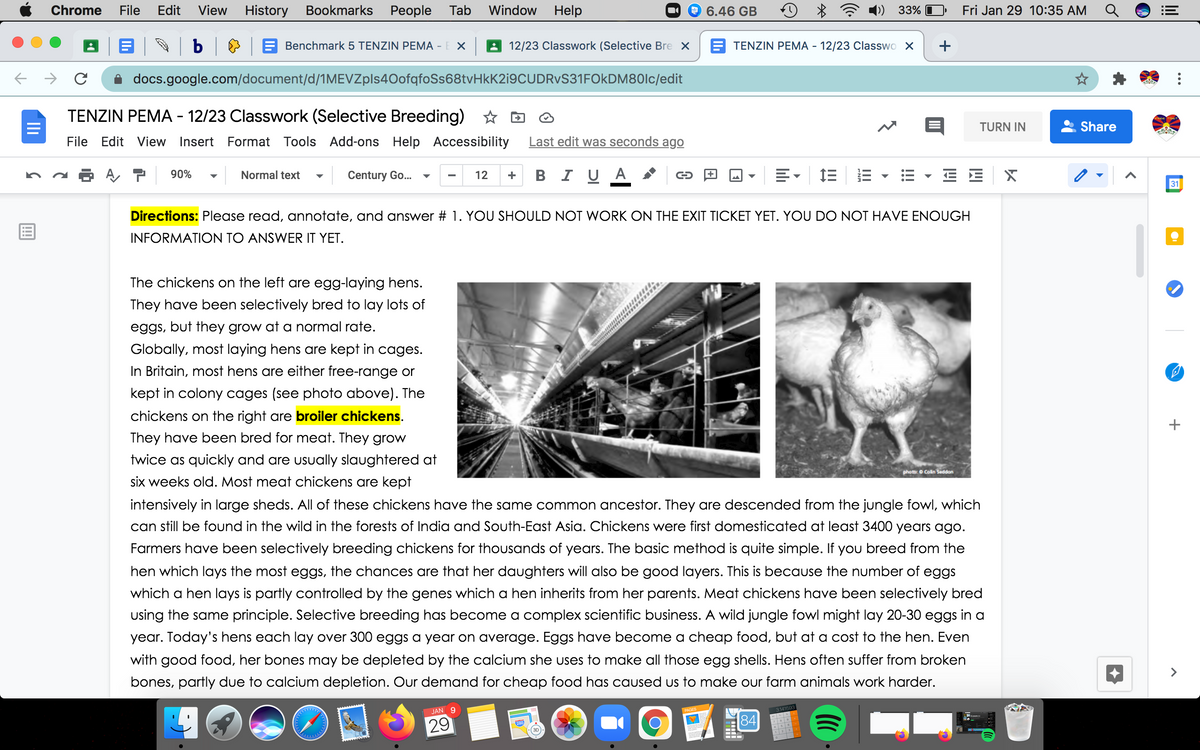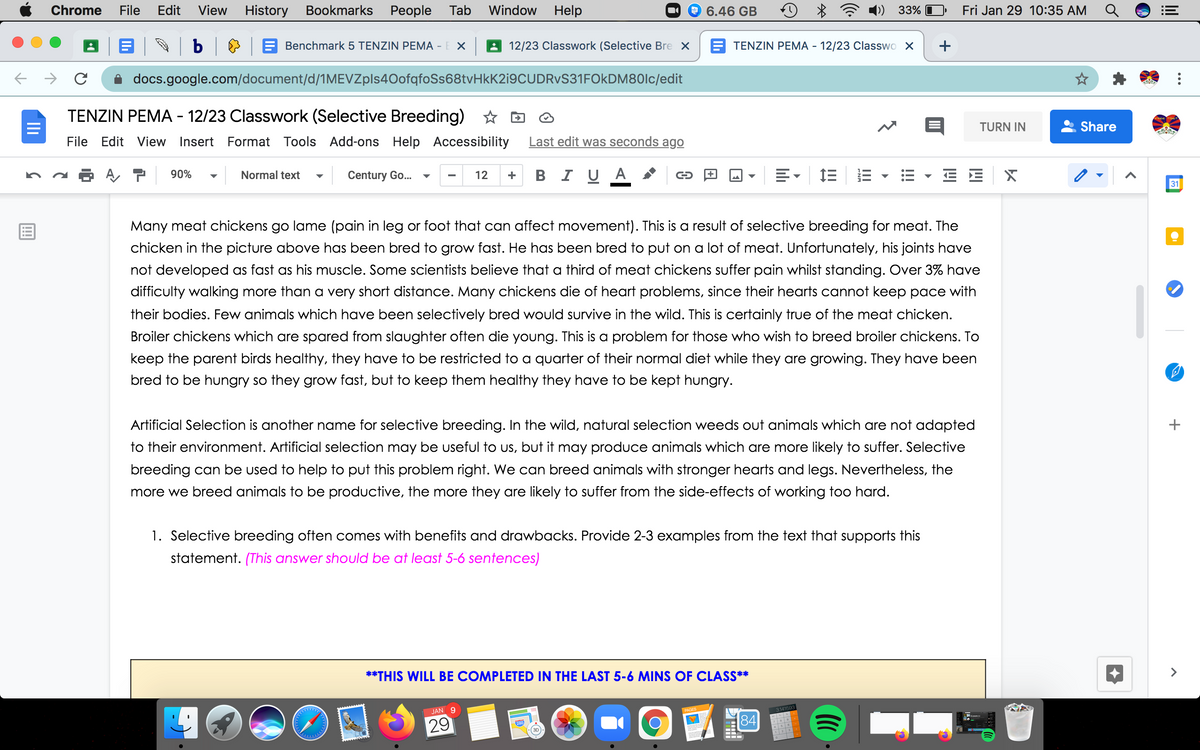1. Selective breeding often comes with benefits and drawbacks. Provide 2-3 examples from the text that supports this statement. (This answer should be at least 5-6 sentences) 2. Should we continue to selectively breed animals or plants? Why
1. Selective breeding often comes with benefits and drawbacks. Provide 2-3 examples from the text that supports this statement. (This answer should be at least 5-6 sentences) 2. Should we continue to selectively breed animals or plants? Why
Biology 2e
2nd Edition
ISBN:9781947172517
Author:Matthew Douglas, Jung Choi, Mary Ann Clark
Publisher:Matthew Douglas, Jung Choi, Mary Ann Clark
Chapter46: Ecosystems
Section: Chapter Questions
Problem 24RQ: Which of the following approaches would be the most effective way to reduce greenhouse carbon...
Related questions
Topic Video
Question
1. Selective breeding often comes with benefits and drawbacks. Provide 2-3 examples from the text that supports this statement. (This answer should be at least 5-6 sentences)
2. Should we continue to selectively breed animals or plants? Why or why not? Use multiple examples (broiler chicken, Belgian blue cows, dogs, dairy cows) in your response. Your answer should be at least 5-6 sentences.

Transcribed Image Text:Chrome
File
Edit
View
History Bookmarks
Реople Tab
Window
Help
9 6.46 GB
33%
Fri Jan 29 10:35 AM
| b | & |
Benchmark 5 TENZIN PEMA - E X
12/23 Classwork (Selective Bre X
TENZIN PEMA - 12/23 Classwo X
+
docs.google.com/document/d/1MEVZpls40ofqfoSs68tvHkK2i9CUDRVS31FOkDM80lc/edit
TENZIN PEMA - 12/23 Classwork (Selective Breeding) *
TURN IN
Share
File Edit View
Insert Format Tools Add-ons Help Accessibility
Last edit was seconds ago
BIU A
E- E E
E E
90%
Normal text
Century Go..
12
+
31
Directions: Please read, annotate, and answ
# 1. YOU SHOULD NOT WORK ON THE EXIT TICKET YET. YOU DO NOT HAVE ENOUGH
INFORMATION TO ANSWER IT YET.
The chickens on the left are egg-laying hens.
They have been selectively bred to lay lots of
eggs, but they grow at a normal rate.
Globally, most laying hens are kept in cages.
In Britain, most hens are either free-range or
kept in colony cages (see photo above). The
chickens on the right are broiler chickens.
They have been bred for meat. They grow
twice as quickly and are usually slaughtered at
photo: O Colin Seddon
six weeks old. Most meat chickens are kept
intensively in large sheds. All of these chickens have the same common ancestor. They are descended from the jungle fowl, which
can still be found in the wild in the forests of India and South-East Asia. Chickens were first domesticated at least 3400 years ago.
Farmers have been selectively breeding chickens for thousands of years. The basic method is quite simple. If you breed from the
hen which lays the most eggs, the chances are that her daughters will also be good layers. This is because the number of eggs
which a hen lays is partly controlled by the genes which a hen inherits from her parents. Meat chickens have been selectively bred
using the same principle. Selective breeding has become a complex scientific business. A wild jungle fowl might lay 20-30 eggs in a
year. Today's hens each lay over 300 eggs a year on average. Eggs have become a cheap food, but at a cost to the hen. Even
with good food, her bones may be depleted by the calcium she uses to make all those egg shells. Hens often suffer from broken
<>
bones, partly due to calcium depletion. Our demand for cheap food has caused us to make our farm animals work harder.
JAN 9
3.141593
84
29
...
lil
+
Ili

Transcribed Image Text:Chrome
File
Edit
View
History Bookmarks
Реople Tab
Window
Help
9 6.46 GB
33%
Fri Jan 29 10:35 AM
| b | & |
Benchmark 5 TENZIN PEMA - E X
12/23 Classwork (Selective Bre X
TENZIN PEMA - 12/23 Classwo X
+
docs.google.com/document/d/1MEVZpls40ofqfoSs68tvHkK2i9CUDRVS31FOkDM80lc/edit
TENZIN PEMA - 12/23 Classwork (Selective Breeding)
TURN IN
Share
File Edit View
Insert Format Tools Add-ons Help Accessibility
Last edit was seconds ago
90%
Normal text
Century Go...
В IU A
E E
12
+
31
Many meat chickens go lame (pain in leg or foot that can affect movement). This is a result of selective breeding for meat. The
chicken in the picture above has been bred to grow fast. He has been bred to put on a lot of meat. Unfortunately, his joints have
not developed as fast as his muscle. Some scientists believe that a third of meat chickens suffer pain whilst standing. Over 3% have
difficulty walking more than a very short distance. Many chickens die of heart problems, since their hearts cannot keep pace with
their bodies. Few animals which have been selectively bred would survive in the wild. This is certainly true of the meat chicken.
Broiler chickens which are spared from slaughter often die young. This is a problem for those who wish to breed broiler chickens. To
keep the parent birds healthy, they have to be restricted to a quarter of their normal diet while they are growing. They have been
bred to be hungry so they grow fast, but to keep them healthy they have to be kept hungry.
Artificial Selection is another name for selective breeding. In the wild, natural selection weeds out animals which are not adapted
to their environment. Artificial selection may be useful to us, but it may produce animals which are more likely to suffer. Selective
breeding can be used to help to put this problem right. We can breed animals with stronger hearts and legs. Nevertheless, the
more we breed animals to be productive, the more they are likely to suffer from the side-effects of working too hard.
1. Selective breeding often comes with benefits and drawbacks. Provide 2-3 examples from the text that supports this
statement. (This answer should be at least 5-6 sentences)
**THIS WILL BE COMPLETED IN THE LAST 5-6 MINS OF CLASS**
<>
JAN 9
3.141593
29
84
+
...
lil
II
Ili
Expert Solution
This question has been solved!
Explore an expertly crafted, step-by-step solution for a thorough understanding of key concepts.
This is a popular solution!
Trending now
This is a popular solution!
Step by step
Solved in 2 steps

Knowledge Booster
Learn more about
Need a deep-dive on the concept behind this application? Look no further. Learn more about this topic, biology and related others by exploring similar questions and additional content below.Recommended textbooks for you

Biology 2e
Biology
ISBN:
9781947172517
Author:
Matthew Douglas, Jung Choi, Mary Ann Clark
Publisher:
OpenStax

Biology: The Unity and Diversity of Life (MindTap…
Biology
ISBN:
9781337408332
Author:
Cecie Starr, Ralph Taggart, Christine Evers, Lisa Starr
Publisher:
Cengage Learning


Biology 2e
Biology
ISBN:
9781947172517
Author:
Matthew Douglas, Jung Choi, Mary Ann Clark
Publisher:
OpenStax

Biology: The Unity and Diversity of Life (MindTap…
Biology
ISBN:
9781337408332
Author:
Cecie Starr, Ralph Taggart, Christine Evers, Lisa Starr
Publisher:
Cengage Learning
